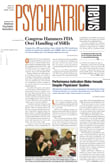New draft standards for patient safety have been issued by URAC, formerly known as the Utilization Review Accreditation Committee.
The voluntary standards are designed to provide a framework for organizations conducting medical-management activities to develop strategies to improve patient safety. They are not intended to be part of the “core standards” by which URAC accredits case management, utilization management, and other related organizations.
But psychiatrists involved in the effort to improve patient safety hope they will become part of those standards.
“The standards are a good first step toward moving the organizations that URAC accredits toward patient safety consciousness,” said Al Herzog, M.D., chair of APA's Committee on Patient Safety. “What I would like to see is for these to become policy directives, so that when these organizations are accredited they are really being held to patient safety standards.”
Albert Vogel, M.D., an APA representative to the URAC Committee on Standards and APA's Area 7 trustee, agreed in his assessment of the standards.“ They are potentially useful as informational standards,” he told Psychiatric News. “They contain good ideas, and my sense is that they are more likely to be useful than problematic.”
URAC accredits health plans, PPOs, case management and utilization management organizations, and health Web sites, among other entities. As a member organization, APA has representatives on the URAC Board of Directors, Standards Committee, and Accreditation Committee.
The URAC standards are part of a wide-ranging effort throughout medicine to reduce errors and adverse events, emphasizing a “systems” approach to replace the standard system of citing individual fault and liability.
That effort was instigated largely by the 1999 Institute of Medicine report, “To Err Is Human: Building a Safer Health System.” The release of the report prompted all sectors of the health care system to play a stepped-up role in reducing medical errors and adverse events that result in potential or actual harm to patients. Medical-management programs, of the kind accredited by URAC, were particularly singled out in the IOM report.
“Medical management organizations have the potential to promote a safer health care system,” said Robert Crocker, M.D., senior vice president and national medical director of WellPoint Health Networks, chair of the URAC Patient Safety Advisory Committee, and vice chair of the URAC Board of Directors.
“URAC has taken a leadership role in developing these informational patient safety standards, created with the intent to actively contribute to a culture of patient safety across the entire health care continuum.”
The new standards cover systems for safety, training and education, tracking and reporting processes, quality improvement, and collaboration.
Vogel and Herzog agreed that as the standards become incorporated into the accrediting process, there is liable to be “push back” from organizations concerned about those standards that are likely to require an outlay of money. “For many of the organizations URAC accredits, quality is secondary to cost,” Herzog said. “But it comes down to how much value you put on patient safety. All of us need to provide safe care. That has to be the prevailing value.”
In the meantime, URAC officials are stressing the voluntary nature of the standards.
“We hope that medical management programs will voluntarily use these informational standards in the evaluation of their operations in order to determine where they can implement changes to promote safety,” said Annette Watson, R.N., a URAC vice president. “However, like many health care organizations, medical-management programs are just beginning to recognize their role in promoting patient safety and may take several years to fully gear up and develop systems needed to do so.
“URAC is not planning a full-scale patient safety accreditation program at this time,” Watson added, “but will continue to advocate for a national patient safety agenda that includes the appropriate involvement of medical management that contributes to a culture of safety throughout the entire delivery system.” ▪
